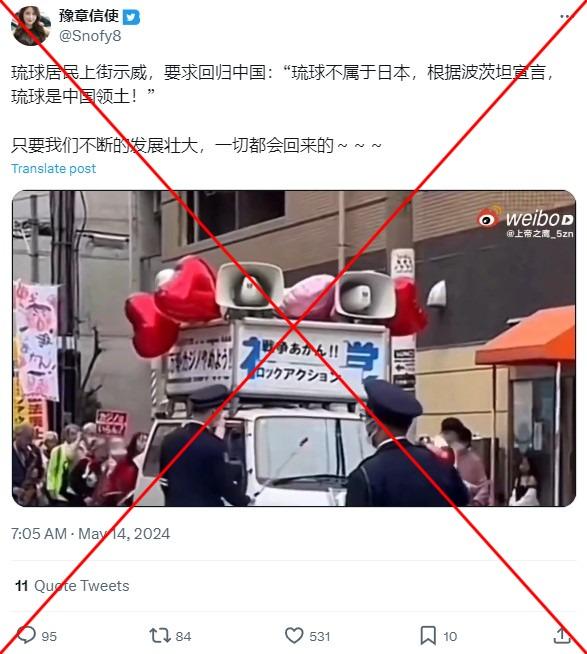
Video shows anti-war protests in Osaka and Tokyo, not residents 'demanding Ryukyu Islands' return to China'
- This article is more than one year old.
- Published on October 22, 2024 at 07:20
- Updated on October 22, 2024 at 07:51
- 3 min read
- By Carina CHENG, AFP Hong Kong
"Ryukyu Islands residents took to the streets to protest, demanding their return to China. Ryukyu Islands do not belong to Japan," read part of the simplified Chinese caption to a video posted on X on May 14, 2024.
"According to the Potsdam Declaration, Ryukyu Islands are Chinese territory," it went on to say.
The video is a compilation of two clips showing street protests. Mandarin chanting heard in the video translates as: "Support the restoration of the Ryukyu Islands! Withdraw US troops from the Ryukyu Islands! The Ryukyu Islands do not belong to Japan, they are Chinese territory!"
Okinawa was once the centre of the Ryukyuan kingdom, which paid tribute to Chinese emperors until it was absorbed by Japan in 1879.

According to an investigation by Japan's Nikkei newspaper in October 2024, a wave of misleading videos declaring Okinawa was Chinese territory has flooded social media since 2023 (archived link).
The report said the misleading posts came after Chinese President Xi Jinping's first public comments on the Ryukyu Islands in June 2023, where he spoke of China's close ties to the islands.
The video was also shared alongside similar claims elsewhere on X, as well as on Facebook, Weibo and Douyin, the Chinese version of TikTok.
But the video does not show residents protesting in Okinawa for a "return" to China.
Anti-war protests
Keyword searches led to a photo shared on Facebook on October 6, 2024 that showed the van seen in the false video at an anti-war protest (archived link).
Below is a comparison of the van seen in the false video (left) and at the protest on Facebook (right):

The Japanese-language post said it showed a protest against the state secret law on December 6, 2013.
Keyword searches on Google using the Japanese characters on the banner atop the van at the front of the rally led to a website titled: "Abolish the war law and the state secret law" (archived link).
They refer to laws passed by Japan's parliament in 2013 and 2015 that critics argued would impinge on press freedom and open the door for Japan's military to fight abroad for the first time since World War II (archived links here and here).
The website records demonstrations that have been held since 2013.
Elements seen in the false video also indicate the video was in Osaka's Nishi ward (archived link).
Below is a screenshot comparison of the falsely shared clip (left) and Google Street View imagery from Osaka (right), with corresponding features highlighted by AFP:

A reverse image search on Google using keyframes from the second clip in the false post led to a longer video published on TikTok on April 29 (archived link).
The TikTok video shows a protest was held in the Shibuya district of Tokyo (archived link).
Below is a screenshot comparison of the falsely shared clip (left) and Google Street View imagery from Tokyo (right), with corresponding features highlighted by AFP:

The rally came after the United States and Japan announced a "significant upgrade" in their defence ties on April 10, aimed at countering China (archived link).
While the Japanese-language protest banners translate as "April 28 Okinawa Day, Shibuya Rally and Demonstration", articles posted by demonstrators (here and here) suggest the rally was an "expression of anger" at the government of then-prime minister Fumio Kishida over fears that conflicts with China could turn Okinawa into a battlefield (archived links here and here).
AFP previously debunked another false claim suggesting Okinawan pupils had celebrated China's national day by singing a patriotic Chinese song.
Copyright © AFP 2017-2025. Any commercial use of this content requires a subscription. Click here to find out more.
Is there content that you would like AFP to fact-check? Get in touch.
Contact us
